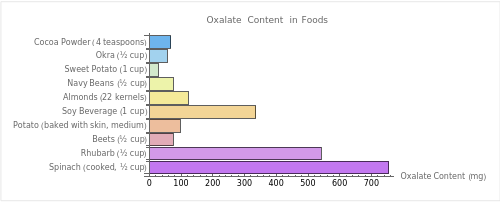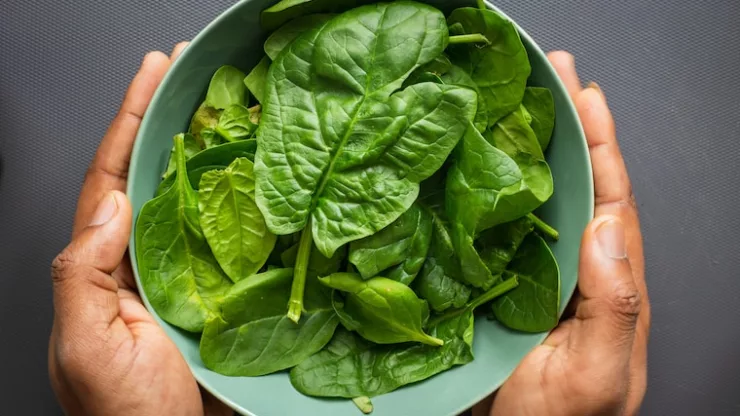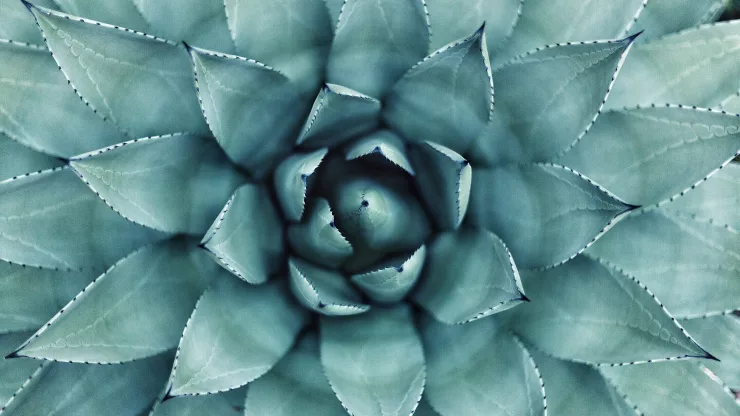Oxalates are organic compounds found in a variety of foods.
While they are naturally occurring and generally harmless in small amounts, a diet high in oxalates can lead to the formation of kidney stones in susceptible individuals.
Here are ten foods high in oxalates that you might want to avoid or limit if you’re trying to reduce your oxalate intake:

1. Spinach
Spinach, whether raw or cooked, is extremely high in oxalates. A half-cup of cooked spinach contains a staggering 755 mg of oxalate, while the same amount of raw spinach contains 656 mg.
While spinach is rich in nutrients like iron and vitamin A, those who are sensitive to oxalates may want to limit their intake.
2. Rhubarb
Rhubarb, a vegetable often used in desserts for its tart flavor, is another significant source of oxalates. A half-cup serving of rhubarb contains 541 mg of oxalate.
3. Beets
Beets, both in their root form and as beet greens, are high in oxalates. A half-cup serving of beets contains 76 mg of oxalate.
4. Potatoes
Potatoes, especially those cooked with their skins, are high in oxalates. A medium baked potato with skin contains 97 mg of oxalate.
Other forms of potatoes, such as mashed potatoes and potato chips, also contain significant amounts of oxalates.
5. Soy Products
Soy and soy-based products are generally high in oxalates. For example, a cup of soy beverage contains 336 mg of oxalate, and an ounce of soy nuts contains 392 mg.
Other soy products, such as tofu and soy cheese, also contain high levels of oxalates.
6. Nuts and Seeds
Certain types of nuts and seeds, particularly almonds and cashews, are high in oxalates. Twenty-two almond kernels contain 122 mg of oxalate, and 18 cashews contain 49 mg.
7. Legumes
Certain types of beans, such as navy beans and refried beans, are high in oxalates. A half-cup serving of navy beans contains 76 mg of oxalate, and the same amount of refried beans contains 16 mg.
8. Sweet Potatoes
Sweet potatoes, while a good source of vitamins and fiber, are also high in oxalates. A one-cup serving of sweet potatoes contains 28 mg of oxalate.
9. Okra
Okra, a staple in Southern and Indian cooking, is high in oxalates. A half-cup serving of okra contains 57 mg of oxalate.
10. Chocolate
Chocolate and chocolate-based products are high in oxalates. For example, four teaspoons of cocoa powder contain 67 mg of oxalate, and a cup of hot chocolate contains 65 mg.
Wrapping It Up
While these foods are high in oxalates, it’s important to remember that everyone’s body is different, and some people may be more sensitive to dietary oxalates than others.
If you’re concerned about your oxalate intake, it’s always a good idea to speak with a healthcare professional or a dietitian.
They can provide personalized advice based on your specific dietary needs and health goals.
| Food | Oxalate Content (mg) |
|---|---|
| Spinach (cooked, ½ cup) | 755 |
| Rhubarb (½ cup) | 541 |
| Beets (½ cup) | 76 |
| Potato (baked with skin, medium) | 97 |
| Soy Beverage (1 cup) | 336 |
| Almonds (22 kernels) | 122 |
| Navy Beans (½ cup) | 76 |
| Sweet Potato (1 cup) | 28 |
| Okra (½ cup) | 57 |
| Cocoa Powder (4 teaspoons) | 67 |
The recommended daily intake of oxalate isn’t universally agreed upon as it can depend on individual health circumstances. However, for those who are prone to forming kidney stones and advised to follow a low-oxalate diet, healthcare professionals often suggest limiting dietary oxalate to less than 50-100 milligrams per day. It’s important to consult with a healthcare provider or a dietitian for personalized advice based on your specific health needs.
High Oxalate Foods FAQ
What are Oxalates?
Oxalates are naturally occurring compounds found in a variety of foods. They are generally harmless in small amounts, but a diet high in oxalates can lead to the formation of kidney stones in susceptible individuals.
Which Foods are High in Oxalates?
Foods that are high in oxalates include spinach, rhubarb, beets, potatoes, soy and soy-based products, certain types of nuts and seeds, certain types of beans, sweet potatoes, okra, and chocolate.
How Much Oxalate is in Spinach?
A half-cup of cooked spinach contains a staggering 755 mg of oxalate, while the same amount of raw spinach contains 656 mg.
Are All Soy Products High in Oxalates?
Yes, most soy-based products are generally high in oxalates. For example, a cup of soy beverage contains 336 mg of oxalate, and an ounce of soy nuts contains 392 mg.
Are There Any Fruits High in Oxalates?
Yes, certain fruits like kiwi, raspberries, and oranges have higher oxalate content. However, the oxalate content in fruits is generally lower compared to other food groups like vegetables, legumes, and nuts.
What Should I Do If I Need to Limit My Oxalate Intake?
If you need to limit your oxalate intake, it’s a good idea to speak with a healthcare professional or a dietitian.
They can provide personalized advice based on your specific dietary needs and health goals.
You may need to limit or avoid foods that are high in oxalates.

With a deep passion for personal development, Ben has dedicated his career to inspiring and guiding others on their journey towards self-improvement.
His love for learning and sharing knowledge about personal growth strategies, mindfulness, and goal-setting principles has led him to create My Virtual Life Coach.
Contact Ben at [email protected] for assistance.




